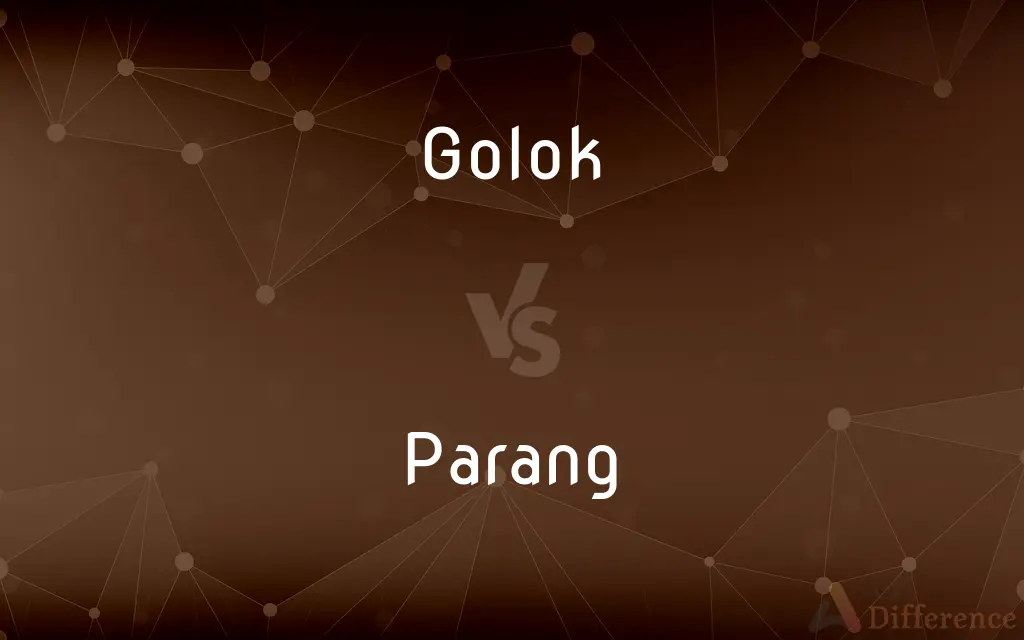Golok vs. Parang — What's the Difference?
By Fiza Rafique & Urooj Arif — Updated on April 24, 2024
Golok, a heavy, curved blade from Indonesia, is primarily used for chopping and slashing; Parang, a Malaysian knife, has a longer blade for cutting through thick vegetation.

Difference Between Golok and Parang
Table of Contents
ADVERTISEMENT
Key Differences
A golok typically features a shorter, heavier blade optimized for forceful cuts and chopping tasks, often found in traditional Indonesian settings. Whereas the parang, prevalent in Malaysia and parts of Southeast Asia, sports a longer, curved blade designed to slice through dense jungle undergrowth.
Goloks are generally robust, with a blade thickness that lends itself well to tasks requiring strength, such as splitting wood. On the other hand, parangs have a slightly thinner blade, making them more suitable for a broad range of cutting tasks, from small branches to larger vegetation.
The handle design of a golok is often straight or slightly curved, which enhances the user's grip during heavy chopping. In contrast, parangs frequently feature an ergonomically curved handle, which increases comfort and control during extended use.
Goloks are usually made with carbon steel, providing durability and ease of sharpening in rugged conditions. Whereas parangs are often crafted from a variety of metals, including stainless steel, which can offer greater resistance to corrosion in humid environments.
The cultural significance of goloks extends beyond their practical use; they are often seen in ceremonial roles in Indonesian culture. Meanwhile, parangs, while also culturally significant, are more commonly regarded as essential tools for survival in the dense forests of Malaysia.
ADVERTISEMENT
Comparison Chart
Origin
Indonesia
Malaysia
Blade Length
Shorter, typically under 20 inches
Longer, often over 20 inches
Blade Shape
Heavier and more curved
Longer and slightly thinner
Handle Design
Straight or slightly curved
Ergonomically curved
Primary Use
Chopping, ceremonial
Cutting through vegetation, survival
Compare with Definitions
Golok
A ceremonial object in some Indonesian cultures.
During the festival, a beautifully decorated golok was displayed.
Parang
A blade with a distinctively curved handle for better grip.
The parang's curved handle made it comfortable to hold for long periods.
Golok
A traditional Indonesian knife with a curved blade.
He used the golok to chop firewood efficiently.
Parang
A Malaysian knife designed for cutting through jungle.
She carried a parang to clear the path ahead.
Golok
A blade made typically from carbon steel.
His golok, forged from carbon steel, had a lasting edge.
Parang
Often longer than a traditional golok.
His new parang was longer than his old golok, making it more versatile.
Golok
A tool often used in farming to clear vegetation.
The farmer sharpened his golok before heading out to the field.
Parang
A tool used for survival in tropical forests.
His parang was essential for survival during the expedition.
Golok
A compact, robust chopping instrument.
The golok's sturdy handle made it easy to manage.
Parang
Commonly made with stainless steel to prevent rust.
The stainless steel parang resisted the humid jungle environment well.
Golok
A golok is a cutting tool, similar to a machete, that comes in many variations and is found throughout the Malay archipelago. It is used as an agricultural tool as well as a weapon.
Parang
Parang is a popular folk music originating from Venezuela and Trinidad and Tobago that was brought to Trinidad and Tobago by Venezuelan migrants who were primarily of Amerindian, Spanish, Mestizo, Pardo, Cocoa panyol, and African heritage, something which is strongly reflected in the music itself. The word is derived from two Spanish words: parranda, meaning "a spree”, and parar meaning "to stop".
Golok
A cutting tool, similar to a machete, used in agriculture and as a weapon in Indonesia and Malaysia.
Parang
A short, heavy, straight-edged knife used in Malaysia and Indonesia as a tool and weapon.
Parang
A short, heavy, straight-edged knife used in Malaysia and Indonesia as a tool and weapon.
Parang
A style of music originating from Trinidad and Tobago, strongly influenced by Venezuelan music.
Parang
To cut with a parang
Parang
To play parang music
Parang
A stout strait-edged knife used in Malayasia and Indonesia.
Parang
A stout straight knife used in Malaysia and Indonesia
Common Curiosities
What is the cultural significance of a parang in Malaysia?
In Malaysia, parangs are seen as essential survival tools in the jungle and hold a practical rather than ceremonial value.
What is the primary use of a golok?
Goloks are primarily used for chopping wood and vegetation.
Are goloks suitable for combat?
While not primarily designed for combat, goloks can be effective due to their robust construction and sharp edge.
What is the advantage of a parang's curved handle?
The curved handle of a parang offers better ergonomic support, reducing hand fatigue during prolonged use.
Is a parang suitable for activities other than cutting vegetation?
Yes, parangs can also be used for food preparation and other campsite tasks.
Are there specific techniques for using a golok effectively?
Yes, using a golok effectively often involves swinging it in a chopping motion, using the blade's weight to aid in cutting.
How does the parang differ from the golok in blade length?
Parangs typically have longer blades than goloks, enhancing their ability to cut through dense jungle.
What materials are commonly used to make goloks?
Goloks are most commonly made from carbon steel.
How often should a parang be sharpened?
A parang should be sharpened as needed, depending on usage frequency and the toughness of the vegetation encountered.
What types of vegetation are goloks best suited for?
Goloks are best suited for chopping thicker, woodier vegetation.
Can a golok be used for survival in a tropical forest?
Yes, a golok can be used for survival, though it is heavier and less specialized for extensive cutting compared to a parang.
How do the weights of goloks and parangs compare?
Goloks are generally heavier than parangs, providing more chopping power but less versatility.
What maintenance is required for a golok to keep it in good condition?
Regular sharpening and oiling are necessary to maintain a golok's condition, especially to prevent rust.
Why might someone choose a parang over a golok?
Someone might choose a parang over a golok for its versatility in handling a variety of jungle tasks and its lighter weight for easier carrying.
Can parangs be customized for different uses?
Yes, parangs can be customized with different blade lengths and handle designs to suit various tasks.
Share Your Discovery

Previous Comparison
Characteristic vs. Quality
Next Comparison
Jocularly vs. JokinglyAuthor Spotlight
Written by
Fiza RafiqueFiza Rafique is a skilled content writer at AskDifference.com, where she meticulously refines and enhances written pieces. Drawing from her vast editorial expertise, Fiza ensures clarity, accuracy, and precision in every article. Passionate about language, she continually seeks to elevate the quality of content for readers worldwide.
Co-written by
Urooj ArifUrooj is a skilled content writer at Ask Difference, known for her exceptional ability to simplify complex topics into engaging and informative content. With a passion for research and a flair for clear, concise writing, she consistently delivers articles that resonate with our diverse audience.














































